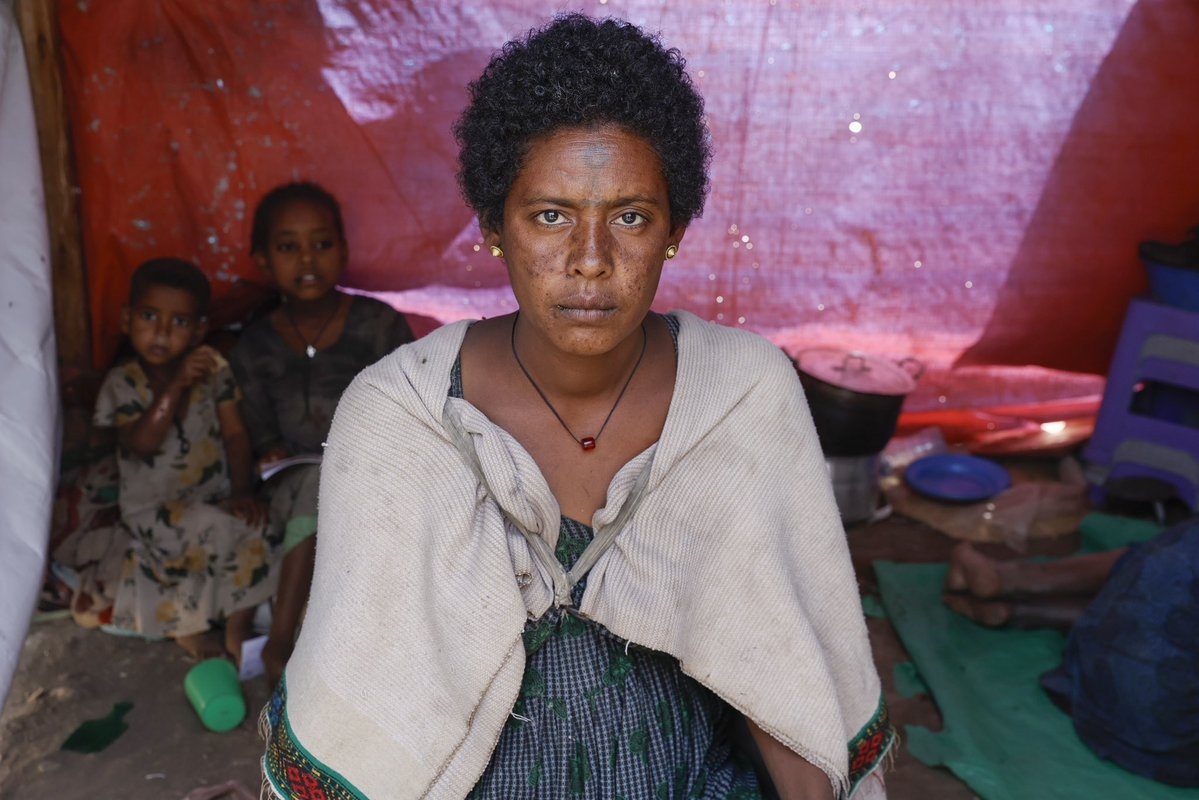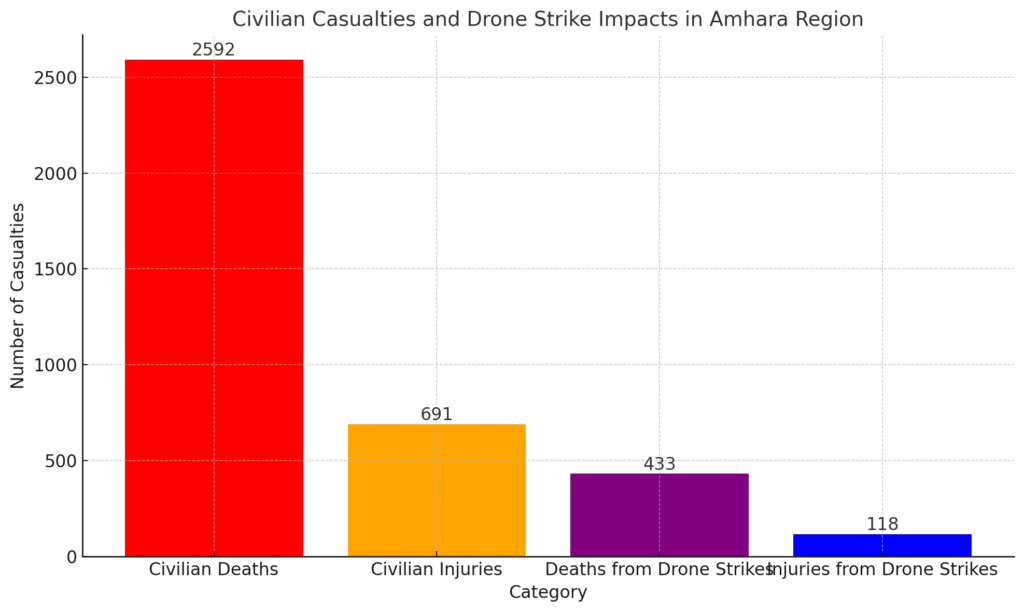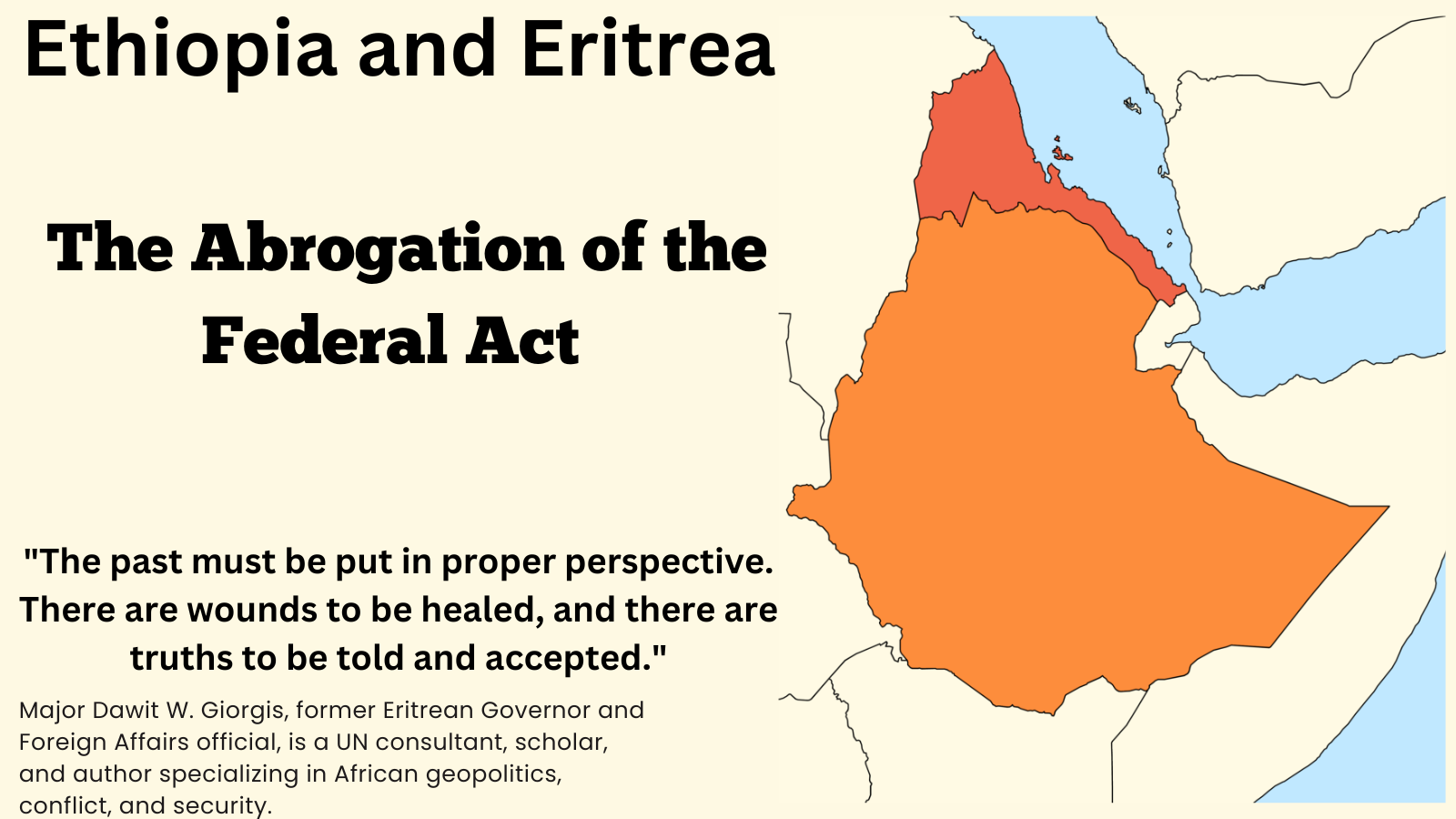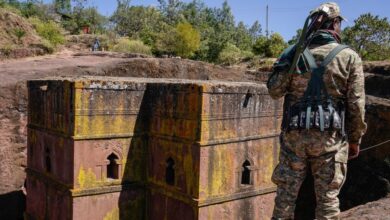Thousands of Civilian Deaths Reported in Ethiopia’s Amhara Region Amid Escalating Conflict

3,283 Civilians Documented as Victims of Violence Since August 2023
Ethiopia’s Amhara region has witnessed a surge in violence over the past year, leading to a devastating toll on civilian lives. A new report by the Amhara Association of America (AAA) has documented 3,283 civilian casualties, with 2,592 people killed and 691 injured between August 2023 and August 2024.

The findings, which underscore the depth of the humanitarian crisis in the region, reveal that civilians have been caught in the crossfire of a complex conflict involving Ethiopian state forces, regional militias, and rebel groups. The AAA’s report sheds light on the harrowing experiences of communities across 16 zones and city administrations, with North Shewa, South Gonder, and East Gojjam identified as the worst-affected areas.

This graph illustrates the regions hardest hit by the violence, with North Shewa, South Gonder, and East Gojjam suffering the most casualties.
Drone Strikes, Massacres, and Widespread Human Rights Violations
The AAA report highlights a disturbing pattern of drone strikes, summary executions, and massacres, particularly targeting civilians in non-combat zones. According to the report, much of the violence has been carried out by the Ethiopian National Defense Force (ENDF), with the support of regional forces.
“Civilians have been disproportionately affected by the military’s operations,” the report states. “The scale of the violence points to deliberate targeting, often outside areas of active conflict.” The report also indicates that the use of drone strikes has contributed to the high civilian death toll, with hundreds of people killed in strikes that have obliterated villages and marketplaces.
In one particularly egregious incident, over 200 civilians in North Shewa were reported killed in what local residents describe as a coordinated military attack. Similar massacres have occurred in South Gonder and East Gojjam, where hundreds more lost their lives.

This chart provides a deeper look into the human cost of the violence, illustrating how many were killed versus those who were injured during the conflict.
Sexual Violence and Looting Rampant Amid Telecommunications Blackouts
The report also documents widespread sexual violence, with hundreds of women and girls falling victim to rape, often in front of their families. These incidents are part of a broader pattern of human rights abuses, which include looting, destruction of property, and enforced disappearances.
The Ethiopian government’s enforcement of a telecommunications blackout in the Amhara region has severely hampered the ability to report ongoing atrocities. This media silence has allowed violence to continue unabated, with the full extent of the devastation only beginning to emerge.
Ethnic Targeting and the Humanitarian Catastrophe
The violence is seen by many as ethnically motivated, raising concerns about potential genocide. With over two million people in Amhara now in urgent need of humanitarian aid, the report suggests that deliberate starvation tactics are being used. Aid blockages have reportedly led to widespread hunger and death by starvation, with aid organizations struggling to reach affected areas.
International Calls for Action as Humanitarian Crisis Deepens
The AAA has called on international bodies, including the United Nations, to intervene and prevent further loss of life. Human rights organizations have also expressed alarm at the findings of the report, urging the Ethiopian government to allow unrestricted access to humanitarian aid and to lift the media blackout.
“The situation in Amhara is a humanitarian catastrophe, and the world cannot look away,” said a spokesperson for Amnesty International. “There is an urgent need for international intervention to stop the ongoing atrocities and ensure accountability for those responsible.”
The full report on the human rights violations and atrocities committed in the Amhara region of Ethiopia is available from the Amhara Association of America (AAA). To read the detailed findings, including drone strikes, massacres, and other forms of violence, please access the report through AAA’s official platform.
Key Findings of the Report
Civilian Casualties
During the reporting period, AAA documented over 3,283 civilian casualties, including 2,592 deaths and 691 injuries. These casualties resulted from more than 200 civilian massacres, 53 drone strikes, and widespread violence across 16 administrative zones in the Amhara and Oromia regions. The Ethiopian National Defense Force (ENDF), along with regional security forces and armed groups such as the Oromo Liberation Army (OLA), were found to be responsible for many of these atrocities, which often targeted civilian populations indiscriminately.
In one of the deadliest incidents, 140 civilians were killed, and over 270 were injured during clashes in Bahir Dar, the capital of the Amhara region. Other zones, including Gojjam, Gonder, and Wollo, also witnessed high casualty numbers, with both state and non-state actors contributing to the violence.
Drone Strikes
The report documents 53 deadly drone strikes, responsible for 433 civilian deaths and 118 injuries. The drone strikes primarily targeted civilian gatherings such as markets, clinics, and schools. One of the most devastating drone strikes occurred on August 13, 2023, in the town of Finote Selam, where a drone targeted a civilian truck, killing 30 people and injuring 50 others. According to the AAA, these strikes were carried out by the ENDF and often hit locations with no active combat, raising concerns about the deliberate targeting of non-combatants.
Sexual Violence
Conflict-related sexual violence (CRSV) was weaponized against the Amhara people, with hundreds of documented cases. Victims include women, girls, and even minors. The report highlights a particularly egregious case on July 5, 2024, in which 43 schoolgirls were gang-raped by ENDF soldiers in Kimir Dingaye. These acts of violence were used as tools of terror, aimed at humiliating and breaking the morale of the Amhara community.
Mass Arrests and Concentration Camps
The Ethiopian government was found to have unlawfully detained thousands of civilians, subjecting them to torture and abuse in secret detention centers across the region. Many high-profile political prisoners, opposition figures, and journalists were also detained during the SoE. Unacknowledged detention sites, described by the report as "concentration camps," were set up to hold those accused of supporting the Fano militia, a local armed group fighting against government forces.
Property Destruction and Forced Displacement
The AAA report documents widespread destruction of homes, schools, and medical facilities. Over 4.1 million children were forced out of school, and thousands of families were displaced due to the ongoing conflict. Many Amharas fleeing violence in the Oromia region sought refuge in the Amhara region, only to face further hardships, including forced relocations by government forces.
Humanitarian Crisis and Blockade
The Ethiopian government was accused of deliberately obstructing humanitarian aid to the Amhara region, where nearly two million people face severe food insecurity. The report also describes how the regime imposed a telecommunications blackout, cutting off mobile and internet services, further isolating the region and preventing the world from witnessing the full scale of the crisis.
Collective Punishment
In several areas, regime forces implemented collective punishment tactics, targeting relatives of Fano fighters. Women, children, and the elderly were taken hostage as leverage to force the surrender of Fano combatants. This method of punishment was used extensively throughout South Gonder, Simada, and Guna Begemidir.
EAR- Editorial Note
This news story is sourced from: https://www.amharaamerica.org/post/report-on-gross-human-rights-violations-and-violations-of-international-humanitarian-law-in-amhara-r




